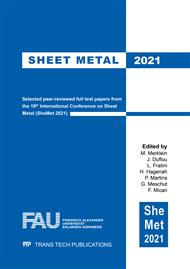p.49
p.57
p.65
p.73
p.81
p.89
p.97
p.105
p.111
Development of a Method for the Identification of Friction Coefficients in Sheet Metal Materials for the Numerical Simulation of Clinching Processes
Abstract:
In order to reduce the fuel consumption and consequently the greenhouse emissions, the automotive industry is implementing lightweight constructions in the body in white production. As a result, the use of aluminum alloys is continuously increasing. Due to poor weldability of aluminum in combination with other materials, mechanical joining technologies like clinching are increasingly used. In order to predict relevant characteristics of clinched joints and to ensure the reliability of the process, it is simulated numerically during product development processes. In this regard the predictive accuracy of the simulated process highly depends on the implemented friction model. In particular, the frictional behavior between the sheet metals affects the geometrical formation of the clinched joint significantly. This paper presents a testing method, which enables to determine the frictional coefficients between sheet metal materials for the simulation of clinching processes. For this purpose, the correlation of interface pressure and the relative velocity between aluminum sheets in clinching processes is investigated using numerical simulation. Furthermore, the developed testing method focuses on the specimen geometry as well as the reproduction of the occurring friction conditions between two sheet metal materials in clinching processes. Based on a methodical approach the test setup is explained and the functionality of the method is proven by experimental tests using sheet metal material EN AW6014.
Info:
Periodical:
Pages:
81-88
Citation:
Online since:
April 2021
Keywords:
Price:
Сopyright:
© 2021 Trans Tech Publications Ltd. All Rights Reserved
Share:
Citation:


